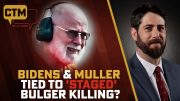
President Obama intends to put the “full weight” of his efforts and his office behind attempts to pass new restrictions on firearms in 2013, he told host David Gregory on NBC’s Meet the Press Sunday. In the year-end interview, the president suggested the catalyst for reform would be the killing of 20 first-grade students and six adults at Sandy Hook Elementary School in Newton, Connecticut, in a December 14 shooting spree that ended with the killer taking his own life.
“I’m going to be putting forward a package and I’m going to be putting my full weight behind it,” Obama said. “I’m going to be making an argument to the American people about why this is important and why we have to do everything we can to make sure that something like what happened at Sandy Hook Elementary does not happen again.”
While stressing the urgency of the matter and holding out the goal of getting new gun legislation passed in the first year of his new four-year term, Obama also said he would await the recommendations of the Task Force on Preventing Gun Violence, headed by Vice President Joe Biden, that he appointed following the Connecticut shootings. All aspects of the problem, including mental health issues, will be part of the “national conversation” the president hopes to lead on the subject. The centerpiece of the legislative package the president will be pushing will be a reenactment of the federal ban on assault weapons that Congress passed in 1994, but allowed to expire 10 years later.
That effort will almost surely be more difficult than it sounds, however, since there is no national consensus on the contentious issue of what is or should be classified as an assault weapon. Connecticut has an assault weapons ban, but the guns used by alleged killer Adam Lanza in the Newton shootings were legal under Connecticut law. The guns were lawfully owned by Lanza’s mother, whom he allegedly killed before going on the shooting rampage at the school.
Opponents of the assault weapons ban point out that the category, applied to several makes of semi-automatic weapons, is a misnomer and is used to cover a number of makes and models not used for military combat. Distinctive features used as criteria for outlawing certain weapons are often cosmetic, opponents of the ban say, like the kind of grip the gun features and fixtures on some rifles for the attachment of bayonets. Critics also argue there is no evidence the ban had any effect on reducing gun violence during the 10 years it was in effect, a period that included the 1999 mass killings at Columbine High School in Colorado.
Following the passage of the ban in 1994, support for it proved politically fatal to several members of Congress who voted for it. The National Rifle Association launched a much publicized and well-financed campaign against supporters of the legislation, and several of the targeted members were defeated in that year’s congressional elections. Enthusiasm for gun legislation in Congress noticeably waned thereafter and a concerted effort to pass gun legislation did not arise after events like the shooting spree that killed 32 and wounded 17 at Virginia Tech in 2007, this summer’s mass killing at a movie theater in Aurora, Colorado and last year’s gun fire in a shopping mall in Tucson, Arizona that killed six and wounded 13, including U.S. Rep. Gabrielle Giffords.
The Newtown killings seemed to have an added shock effect, however, given that the victims included 20 children aged six and seven. Advocates of firearms restrictions have also argued since the Connecticut shooting that the influence of the “gun lobby” — specifically the NRA — is declining and has long been exaggerated. Most of the organization’s members do not agree with the leadership’s opposition to proposed restrictions, they claim.
While saying he did not want to “prejudge” recommendations on dealing with gun violence, Obama in his Meet the Press interview was obviously cool to the NRA’s call for a federal effort to protect schoolchildren by placing armed guards in every school in the country.
“I am skeptical that the only answer is putting more guns in schools. And I think the vast majority of the American people are skeptical that that somehow is going to solve our problem,” the president said.
“I’ve been very clear that an assault-rifle ban, banning these high capacity clips, background checks, that there are a set of issues that I have historically supported and will continue to support,” Obama said. “And will there be resistance? Absolutely there will be resistance. And the question then becomes, you know, whether we are actually shook up enough by what happened here that it does not just become another one of these routine episodes where it gets a lot of attention for a couple of weeks and then it drifts away.” The key to enacting reforms, he said, will be in organizing and mobilizing public opinion to support them.
“But ultimately the way this is going to happen is because the American people say, ‘That’s right. We are willing to make different choices for the country and we support those in Congress who are willing to take those actions,'” he said.
Photo of President Obama: AP Images
Related articles:
NRA’s Response to Sandy Hook: Federally Funded Police in Every School
Gun-free Zones Called “Magnets for Mass Shooters”



